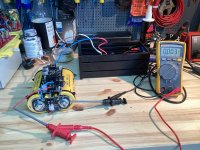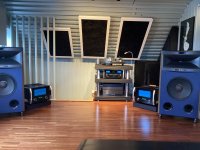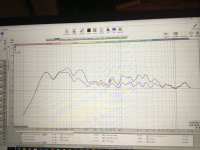The law of diminishing returns certainly can be applied at this stage of Ian's development. Unless, of course, you have a highly resolving audio system - and many members surely do. So, it's the ole adage, is there 'enough' real sonic improvement to justify the additional cost involved. I get it. We all like to build, tinker, and listen (not necessarily in that orderI don't know Ian's further plans, but I hope that after high-end FiFO circuits and special power supplies, he will start to redevelop the DAC. I am thinking of a similar R2R DAC to the one Soekris designed and sells. It would be a real coup if he could beat his own Holo DAC.
In the FiFO product line, after Q7, new clocks and UCPure, I don't think it will be easy to make any further significant quality difference.
I am a bit of a newby here but read most of this thread with great attention. I did own years back a DDDAC then having a Raspberry Pi 3B+ with the first FiFoPi, with Accusillicon clocks, ReclockPi connected to the I2S of the DDDAC. I still wonder why I ever sold this set because it sounded fantastic.
Now I have gone a whole different way. I have a commercial DAC and a commercial streamer. My DAC is a Chord Dave, modded with better caps and with its stock SMPS removed, replaced with three Farad Super 3’s. This DAC configuration is very much to my likings. Unfortunately it is very sensitive to RF and AC noise so I want to keep things clean. Meaning I want to use optical SPDIF. I don’t care much for high resolution. Most I listen to is 16/44 or 24/96 and some 24/192.
The rest of my set is also quite good and I recently acquired the much praised Grimm MU1. A dream for many audiophiles and I can tell you, it does sound fantastic.
However, it has two downsides, one is it has no optical SPDIF output which is the best input for Dave. And it also has a SMPS that pollutes my AC a bit- and unfortunately even it is a bit, I hear it affecting the stage of my Dave.
I noticed this with a small investment, besides the Grimm I have a Raspberry Pi4 with Hifiberry Digi2 Pro on top of it, powered with a Farad Super 3 5V and a USB-C DC cable. And even though the mids of the Grimm are not matched, the stage of the Hifiberry is already larger than the Grimm which is a bit of a surprise. It shows me the potential of a Raspberry configuration.
So I want to build the best possible Raspberry based transport that does not pollute my AC and has optical. As to my memory the Ian Canada components were so good, this is what I want to try again.
My idea is to keep things simple: a transport based on Pi 4 or Pi 3B+ (I have both) with FiFoPi Q7 and TransportPi so I have optical SPDIF. I am a huge fan of the Farad Super 3 so I would use two of those, a 3.3V and a 5V.
Is it as simple as getting a StationPi Pro, a ShieldPi Pro, a Pi 4, a FiFoPi Q7, a set of AccuSillicon 45M and 49M clocks, and a Transport Pi connecting the Farads?
If yes, one other concern. The Farads have a considerable power up time and the moment they start their DC flow is unpredictable. I don’t know which one will come up first, the 5V or the 3.3V one. Do I damage the setup if one comes a substantial amount earlier than the other? If yes how do I prevent that?
Last but not least what is better in this use case, Pi4 or Pi3B+?
Now I have gone a whole different way. I have a commercial DAC and a commercial streamer. My DAC is a Chord Dave, modded with better caps and with its stock SMPS removed, replaced with three Farad Super 3’s. This DAC configuration is very much to my likings. Unfortunately it is very sensitive to RF and AC noise so I want to keep things clean. Meaning I want to use optical SPDIF. I don’t care much for high resolution. Most I listen to is 16/44 or 24/96 and some 24/192.
The rest of my set is also quite good and I recently acquired the much praised Grimm MU1. A dream for many audiophiles and I can tell you, it does sound fantastic.
However, it has two downsides, one is it has no optical SPDIF output which is the best input for Dave. And it also has a SMPS that pollutes my AC a bit- and unfortunately even it is a bit, I hear it affecting the stage of my Dave.
I noticed this with a small investment, besides the Grimm I have a Raspberry Pi4 with Hifiberry Digi2 Pro on top of it, powered with a Farad Super 3 5V and a USB-C DC cable. And even though the mids of the Grimm are not matched, the stage of the Hifiberry is already larger than the Grimm which is a bit of a surprise. It shows me the potential of a Raspberry configuration.
So I want to build the best possible Raspberry based transport that does not pollute my AC and has optical. As to my memory the Ian Canada components were so good, this is what I want to try again.
My idea is to keep things simple: a transport based on Pi 4 or Pi 3B+ (I have both) with FiFoPi Q7 and TransportPi so I have optical SPDIF. I am a huge fan of the Farad Super 3 so I would use two of those, a 3.3V and a 5V.
Is it as simple as getting a StationPi Pro, a ShieldPi Pro, a Pi 4, a FiFoPi Q7, a set of AccuSillicon 45M and 49M clocks, and a Transport Pi connecting the Farads?
If yes, one other concern. The Farads have a considerable power up time and the moment they start their DC flow is unpredictable. I don’t know which one will come up first, the 5V or the 3.3V one. Do I damage the setup if one comes a substantial amount earlier than the other? If yes how do I prevent that?
Last but not least what is better in this use case, Pi4 or Pi3B+?
Hello guys, I need your kind advice, I can't find and answers with the search tool.
Currently I use a RP3B with ropieee to stream via USB to a Shiit Yggdrasil
i found on youtube than the purepi would be a nice upgrade, is there anything else I could use to achieve a better level?
(I see everything is leaning towards I2S or coaxial)
Currently I use a RP3B with ropieee to stream via USB to a Shiit Yggdrasil
i found on youtube than the purepi would be a nice upgrade, is there anything else I could use to achieve a better level?
(I see everything is leaning towards I2S or coaxial)
For the USB output I cannot give you any hints with Ian's boards. Other people here can for sure chime in and share their experiences with Ian's boards and also the USB boards of other suppliers (Andrea?).
I have't sold my Yggdrasil yet, it is last generation, but with the older USB input. I followed the discussion with the new USB, and the people are indifferent with a good AES (SPDIF) or the newer USB input. I've used the AES of PI2AES and it was obviously better than any other input.
My recommendation would be to take Ian's TransportPi AES and build the streamer referred here somewhere. If you use the search function and my nick name, you'll find it quickly, and also the modules I'll buy.
I have't sold my Yggdrasil yet, it is last generation, but with the older USB input. I followed the discussion with the new USB, and the people are indifferent with a good AES (SPDIF) or the newer USB input. I've used the AES of PI2AES and it was obviously better than any other input.
My recommendation would be to take Ian's TransportPi AES and build the streamer referred here somewhere. If you use the search function and my nick name, you'll find it quickly, and also the modules I'll buy.
Hi Cucotl,Hello guys, I need your kind advice, I can't find and answers with the search tool.
Currently I use a RP3B with ropieee to stream via USB to a Shiit Yggdrasil
i found on youtube than the purepi would be a nice upgrade, is there anything else I could use to achieve a better level?
(I see everything is leaning towards I2S or coaxial)
Which version of the USB-board do you use in your Yggdrasil? The gen V USB-board in my Yggdrasil is not as good as the DAC's AES and SPDIF inputs (regardless of the streamer I used). I agree with the previous poster and also recommend using this hat on your RP3B: https://github.com/iancanada/DocumentDownload/tree/master/TransportPi/TransportPiAES . Are you already using a FifoPi board, better clocks and a ReclockPi?
I read the complete official blog and forum concerning the Yggdrasil (Headfi and the forum where are only superbest audio friends), (what a waste of time), and then many people with clearly differentiated thoughts were unclear what to prefer. For me it seemed that it depends on the quality of the streamer. So, if it is easier for you to use one, chose this. Yggrasil treats every digital input equal, so you don't have any restrictions.
When I remember correctly, on Andrea Mori (is it allowed to say his name here in the forum ;-) ) has a USB input. I don't know if Ian has, too, and I don't have any idea if it is worth to go that rout, just because I don't like to use USB. But I am just one of several billion human beings.
When I remember correctly, on Andrea Mori (is it allowed to say his name here in the forum ;-) ) has a USB input. I don't know if Ian has, too, and I don't have any idea if it is worth to go that rout, just because I don't like to use USB. But I am just one of several billion human beings.
UcPure mkIII-UcBalancer kit-Eaton 2.7v 3000 Farad, Listening impression.
A week ago I received the UcBalancer kit from Ian, and i finally could put together my UcPure psu. It feed the Accusilicon 338 clocks with 3.3vdc UcPure power.
Music has been played daily, and I must say that my dddac sound better than ever before. Compared to LinearPi with UcConditioner, UcPure add more clarity and dynamics, not a big difference, but for me I think it’s worth it. It’s like the listening window is a little bit cleaner, and bass is tighter and cleaner.
My conclusion, is that if you have a revealing system, I will suggest you give the UcPure psu with UcBalancers a try.
My system :
Turntable. Diy ( granite plinth and massive alu platter) Jelco 850 L- Mk II tonearm.
Streamer. Aurender- N100h
Preamp. McIntosh C-52
Amps. McIntosh 1.2 kw mono blocks
Speakers. JBL 4365 ( Nordost Valhalla internal, and external wiring)
Room treatment: Mini dsp flex, Corner absorbers, roof absorbers, and a big Helmholtz resonator behind listening pos.
Pics of setup, and how it measures. The lower line of measurements is after dsp correction.
A week ago I received the UcBalancer kit from Ian, and i finally could put together my UcPure psu. It feed the Accusilicon 338 clocks with 3.3vdc UcPure power.
Music has been played daily, and I must say that my dddac sound better than ever before. Compared to LinearPi with UcConditioner, UcPure add more clarity and dynamics, not a big difference, but for me I think it’s worth it. It’s like the listening window is a little bit cleaner, and bass is tighter and cleaner.
My conclusion, is that if you have a revealing system, I will suggest you give the UcPure psu with UcBalancers a try.
My system :
Turntable. Diy ( granite plinth and massive alu platter) Jelco 850 L- Mk II tonearm.
Streamer. Aurender- N100h
Preamp. McIntosh C-52
Amps. McIntosh 1.2 kw mono blocks
Speakers. JBL 4365 ( Nordost Valhalla internal, and external wiring)
Room treatment: Mini dsp flex, Corner absorbers, roof absorbers, and a big Helmholtz resonator behind listening pos.
Pics of setup, and how it measures. The lower line of measurements is after dsp correction.
Attachments
OK, thanks for your answer.Yes,FiFoPi Q7 is better.
Hey Guys, I have a question concerning one of Ian's stacks to run various forms of DSD. Although the FIFOPI3 can : "Supports Native DSD from DSD64 to DSD1024"
I found that I cannot get more than DSD 128 in either native or DoP. It will not play DSD 256 in either case. The 9038Q2MPi Dual Mono Plus DAC manual indicates: "native DSD1024, and DSD256 via DoP". However while it runs DSD 128 just fine, 256 has not met with success either native or DoP. In any case the objective is to configure for native DSD to at least 256. Any thoughts or suggestions appreciated.
I found that I cannot get more than DSD 128 in either native or DoP. It will not play DSD 256 in either case. The 9038Q2MPi Dual Mono Plus DAC manual indicates: "native DSD1024, and DSD256 via DoP". However while it runs DSD 128 just fine, 256 has not met with success either native or DoP. In any case the objective is to configure for native DSD to at least 256. Any thoughts or suggestions appreciated.
Thank you for your reply, I'll try the transportPi way.For the USB output I cannot give you any hints with Ian's boards. Other people here can for sure chime in and share their experiences with Ian's boards and also the USB boards of other suppliers (Andrea?).
I have't sold my Yggdrasil yet, it is last generation, but with the older USB input. I followed the discussion with the new USB, and the people are indifferent with a good AES (SPDIF) or the newer USB input. I've used the AES of PI2AES and it was obviously better than any other input.
My recommendation would be to take Ian's TransportPi AES and build the streamer referred here somewhere. If you use the search function and my nick name, you'll find it quickly, and also the modules I'll buy.
(I saw youtube video of the Gabbster streamer and look great.
I have the newest board with the usb upgrade ( I even invest in some snake oil on my usb cable) I dont have any Ian's products yet.Hi Cucotl,
Which version of the USB-board do you use in your Yggdrasil? The gen V USB-board in my Yggdrasil is not as good as the DAC's AES and SPDIF inputs (regardless of the streamer I used). I agree with the previous poster and also recommend using this hat on your RP3B: https://github.com/iancanada/DocumentDownload/tree/master/TransportPi/TransportPiAES . Are you already using a FifoPi board, better clocks and a ReclockPi?
I read the complete official blog and forum concerning the Yggdrasil (Headfi and the forum where are only superbest audio friends), (what a waste of time), and then many people with clearly differentiated thoughts were unclear what to prefer. For me it seemed that it depends on the quality of the streamer. So, if it is easier for you to use one, chose this. Yggrasil treats every digital input equal, so you don't have any restrictions.
When I remember correctly, on Andrea Mori (is it allowed to say his name here in the forum ;-) ) has a USB input. I don't know if Ian has, too, and I don't have any idea if it is worth to go that rout, just because I don't like to use USB. But I am just one of several billion human beings.
I dont like that SBFA forum, not a friendly place.
but I'll give this streamer a try.
Hey Guys, I have a question concerning one of Ian's stacks to run various forms of DSD. Although the FIFOPI3 can : "Supports Native DSD from DSD64 to DSD1024"
I found that I cannot get more than DSD 128 in either native or DoP. It will not play DSD 256 in either case. The 9038Q2MPi Dual Mono Plus DAC manual indicates: "native DSD1024, and DSD256 via DoP". However while it runs DSD 128 just fine, 256 has not met with success either native or DoP. In any case the objective is to configure for native DSD to at least 256. Any thoughts or suggestions
Hi, i have upgraded to the Q7 from the q3 with reclockpi and i can say that the Q7 is an improvement.. it is more analog sounding. Closer to vinyl. In my system, the q7 didn’t need the reclockpi. It sounds more right without the reclockpi in the q7 chain. Also, the hdmipi pro is a must (a lot better than hdmipi) if you’re using the i2s.Has anyone compared the FifoPi Q7 with the FifoPi Q3+ReclockPi? I am wondering if upgrading makes sense. Thanks in advance for your reply.
Hope this helps
This is also my opinion.I dont like that SBFA forum, not a friendly place.
This is why they had to put Super and Best and Friends in the forum's name in the first place!
Someone also upgraded to Q7 from FifoPiMa? Is there something to gain apart from isolation?Hi, i have upgraded to the Q7 from the q3 with reclockpi and i can say that the Q7 is an improvement..
Thanks
- Home
- Source & Line
- Digital Line Level
- Asynchronous I2S FIFO project, an ultimate weapon to fight the jitter



